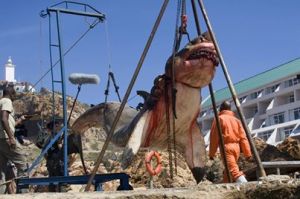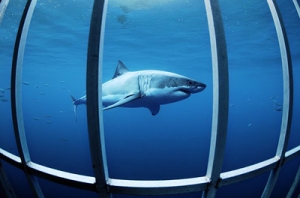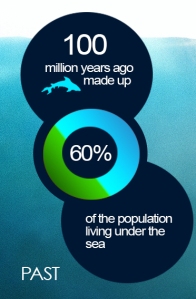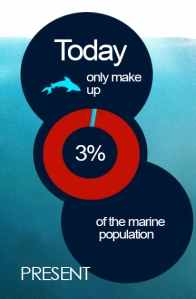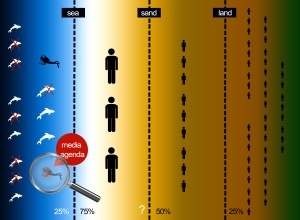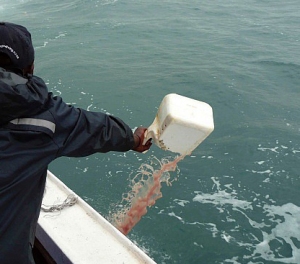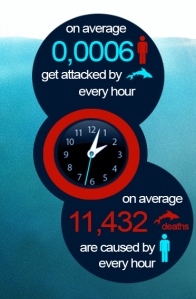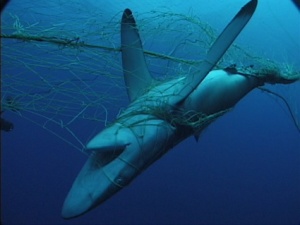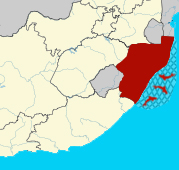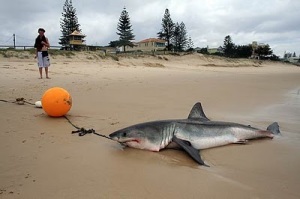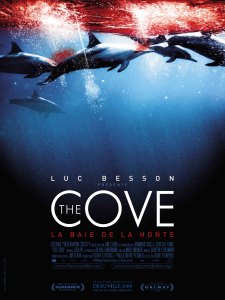Whose claiming possession of the sea?
Annexure A
Most people have an irrational fear of sharks and the media is to blame with their brutal portrayal of the shark and the shark attack with its gore and sensationalism. It is this media-hyped fear of sharks that sells magazines, books and increases TV shows and film ratings. It is our morbid sense of thrill nurtured by the media that cause a fearful curiosity leading to an interesting fascination with this large predatory fish. In the newspapers and Media sharks have been framed as vicious killers who violently and spontaneously attack their unknowing innocent human victims. The media sensationalises each attack and uses discourse, which encourages the interest of the onlookers, which has already been built up over time through blockbuster movies, stories and reported shark attacks.
“We don’t just fear our predators, we are transfixed by them.
This perception was acerbated by Peter Benchley, (the author of “Jaws,” the novel which became the Steven Spielberg Hollywood film production about a fictional Great White), once said, “We don’t just fear our predators, we are transfixed by them.”
Annexure B
 In a deeply tribal way, we love our monsters.” (Benchley) In reality it is films like “Jaws” that have instilled this fear of sharks in humans. Time Magazine called 2001 the “Summer of the Shark.” Just off Pensacola, Florida a bull shark bit the arm off an 8-year-old boy this particular event started a media frenzy and since this event, any human interaction with a shark, no matter how insignificant, made front-page news. It is the journalists and reporters that villianize and stereotype sharks and this was no accident it was a deliberate ploy by the media to capitalize of humans’ love of fear. A tragic situation as it is the sharks who are now in fact in desperate need of our protection.
In a deeply tribal way, we love our monsters.” (Benchley) In reality it is films like “Jaws” that have instilled this fear of sharks in humans. Time Magazine called 2001 the “Summer of the Shark.” Just off Pensacola, Florida a bull shark bit the arm off an 8-year-old boy this particular event started a media frenzy and since this event, any human interaction with a shark, no matter how insignificant, made front-page news. It is the journalists and reporters that villianize and stereotype sharks and this was no accident it was a deliberate ploy by the media to capitalize of humans’ love of fear. A tragic situation as it is the sharks who are now in fact in desperate need of our protection.
The other side of the coin a far more current environmental issues the declining numbers of sharks in our waters due to the human interference in their habitat. Sharks one of evolution’s most perfect creations. Many of them have not changed in millions of years and yet their populations are dwindling – Annexure C one hundred million years ago, sharks made up about 60% of the population living under the sea.
Looking back
Awareness to the plight of sharks
Annexure D
Today sharks only make up 3% of the marine population.(Walter 2011) They play a critical role in ocean ecosystems, they regulate the populations of all marine species below them in the food chain. When sharks are killed in large numbers there is a risk of the collapse of the balance of the ocean, which will have dire consequences. Studies are already indicating that regional elimination of sharks can cause disastrous effects. These include the collapse of fisheries and the death of coral reefs. (Friedlander) By looking after sharks, we look after the oceans and our future as well. Sharks pose minimal risk to humans and yet we seem hell bent on destroying their habitat and in doing so killing them off.
Bringing awareness to the environmental plight of sharks is definitely a tough one because very few people have any empathy for them after all these are people who have been influenced by media hype and exploitation of the shark deadly mystique. At the end of the day it has to be up to “responsible media” – refers to a media who can see past the sensationalism aspect and one that is not motivated by greed or money to reverse the negative perceptions of these animals. These are the people who have the power in society to do this in order to bring about change that will protect and sustain these animals. It must be left up to this media to define this environmental issue through well-orchestrated, emotive communication strategies.
chumming the water
Annexure E
We are invading the sharks’ habitat not only by our recreational activities but also by altering the sharks’ natural behaviour by interfering with their natural lifestyle and environment and then make a song and dance about the tragic consequences of our unnatural intervention with these predatory creatures (like a shark attack). We were never meant to co-exist we are terrestrial beings not marine creatures. It is our selfish wants and desires that disturb the balance of life in the ocean.
Annexure F
Reasons why sharks have attacked are investigated and debated at length. These reasons being varied ranging from increased recreational use by humans of the ocean, chumming the water (is the act of luring animals, usually fish or sharks, by throwing “chum” into the water. Chum often consists of fish meat, which attracts fish, particularly sharks due to their keen sense of smell). This is often done purely for shark viewing. It is seen as an adrenaline rush to shark dive as the dangers of the creature although somewhat true to be a sport with playing with ones life and a feat to achieve. Yet sharks in the academic world of marine studies have been stipulated to be passive creatures that eat to survive.
Overfishing and depleting the sharks food sources, cage diving, global warming has also been blamed because it affects ocean temperatures and currents and even low cost travel has been blamed for the increase in shark attacks enabling people to swim, snorkel, surf or dive in places that previously had no human presence. Man are killing sharks for medicinal purposes (believing they could hold a cure for cancer) or eating them in shark fin soup (which is considered a delicacy in China). Our shark nets and drumlines that are killing our marine life including sharks at the rate of knots. Many diverse reasons that have one thing in common – they are all caused by man to fulfill his needs and wants.
A five-metre great white shark killed a surfer at Kogel Bay just outside Gordon’s Bay on the 19 April 2012. In the weeks before this attack, chumming had made headlines because of filming for the documentary” Shark Men”, which involved research being done in False Bay and on the southern Cape coast. A tragedy which the voracious media leapt on. After all it is stories like this that sells magazines and newspapers. There was a dip in the media around this issue until the attack of the young surfer arouse. It was only after the attack that the environmental affairs department cancelled the permits enabling the programme and research to go ahead. (Dolley 2012) Too late for one promising young springbok board surfer but a golden opportunity for the media who have a conscience and look for answers beyond just the gory, sad story!!
Behind the numbers
Annexure G
Statistically the number of sharks that attack humans every year is a minuscule average of 5, in comparison to the number of shark deaths caused by humans globally is huge at 100 million a year- that is 11,432 every hour.( Leeper 2004)(This has forced many species of sharks into the critically endangered category of endangered animals. Yet everyone appeared to be up in arms from conservations, ecologists, marine biologists to the public because of a death of a surfer – an emotive and emotional story. The good news is that this tragedy allows sectors of the media to focus on the shark not as the deadly predator responsible for a death but rather as a victim of his circumstances.
Environmental issues that man has brought upon this animal to his complete detriment. It seems ironic that a violent shark attack brings more focus of sharks due to the publicity of the incident and thereby bringing awareness to the plight of these creatures. An opportunity that is not lost on those who want to bring their side of the issue into the forefront of the public eye.
The initial media frenzy is focused on the actual attack with all it’s graphic details and sensational photographs seen on the front pages of the newspapers, on TV, blog sites and on the internet. The positive repercussion is that people start questioning and debating the reasons for the attack, interest in sharks and consequently their predicament is heightened. A perfect platform for eco journalists who have the communication tools to publicize the environment issues that pertain to the sharks. To use their powers of persuasion to influence interested parties to see the shark not as a monster but an animal who is fighting for it’s own survival and the underlying reasons for it’s unnatural behaviour. It is the media that defines environmental issues in order to bring about change for the betterment of our seas and the world.
Shark Attack Buzz
Annexure H
Shark Attack 3: Megalodon a youtube video posted four years ago has been viewed 39 665 635 times to date showing the interest of the public on shark attacks. In this clip the computer enhanced great white is seen to be a senseless creator devouring any human who tries to escape it.
http://www.youtube.com/watch?v=1nzd0R_OeOc
The keywords ‘shark attack’ are hugely searched on Youtube and this is evident in the amount of millions of views the videos have recieved. The negative denotation of the word ‘attack’ already embedded in society as a ruthless action, which causes harm to the victim, is used to evoke a sense of violence to the nature of the shark. The media has burdened sharks as a destructive creature set on ‘attacking’ and taking lives of the innocent and this almost becomes a form of entertainment in a sick and twisted way. Images of raggered amputations of legs and bite marks are always the dominating image of any shark attack story. Humans have been desensatised as many studies have shown in the past and often look for things that scare them or give them reason to fear in a sinisterly entertaining way. The mourning families are often the next step in the media cycle showing the after math of the brutal attack of the senseless animal. Doesn’t the shark know what it has done? No and this is why campaigns interms of education was needed to be put in place. The Shark board aims to help people understand and connect with the sharks by having safety talks and explanations to why a shark acts in certain ways. Although at the end of every tour a shark is cut up and put on display, which can be questionable to the morals of the onlookers. Are they their out of curiosity, knowledge of the creature or to see the ‘dangerous’ predator up close and personal?
Shark conservation efforts find themselves in position where they are competing with irrational fears of the public and unreasonable and unbalanced risk perceptions by them hamper the social and political power of conservation and limit their choices and efficientness . Even the emotive word “ attack ” according Christopher Neff, (a PhD researcher at the University of Sydney in the Department of Government and International Relations. He is studying the “politics of shark attacks” in Australia, South African and the United States.) “put Shark conservation efforts in a position where they are competing with fears and disproportionate risk perceptions that limit the social and political power of conservation and limit options and effectiveness.”( Neff C 2011The political fallout from a record number of 12 fatal shark attacks in 2011 continues to emerge across the globe. (World News on msnbc .com 2012) The politics behind this is blatantly clear, the sharks are too blame and attention is placed on relieving the public’s anxiety.
In February 2012, three beach locations in three different countries announced intentions to add some form of shark nets to their beaches following recent shark bites. Reunion Island, located in the Indian Ocean east of Madagascar, about 200 km south west of Mauritius the beach near Belmont Baths in New South Wales, Southern Australia is pushing for the erection of gill nets and Fish Hoek beach in Cape Town South Africa announced at the end of February that it would be “considering a proposal to begin a trail of shark exclusion nets”. (Neff,C 2012)
With today’s ever-improving information and communication technology, the media has the advantages of both speed (in terms of conveying instantaneous information) and reach (the number of people getting the news). Media who take their jobs seriously will exploit these advantages to the full to convey their point of views. For this to be most effective it is not just about releasing stats, information and justifications but getting into the soul of the public -getting the public to be empathetic and sympathetic with the issues in this case the plight of the shark.
The media in order to be successful in their endeavor to communicate an environment issue has to educate, inform, to promote the public’s appreciation of the inherent values and benefits that the natural environment provide, aid positive popular action for the environment by encouraging people to take initiative in contributing to the specific environmental sustainability. There is only one way to do this by persuasion – the goal of most media messages is to persuade the audience to believe or do something.
South Africa’s net worth
Annexure I
An environmental issue that faces South Africa is that of our shark nets and the negative impact it has on our marine life. South Africa is a country of double standards. While South Africa has led the world in the protection and conservation of sharks: “South Africa was the first country in the world in 1991, to bring in legislation to protect Great White Sharks,” yet they also allow sharks which are caught in their nets to die. (Andersen 2008) It is all about giving the swimmer safety because a shark attack impacts on tourism, business and the economy. It is essentially all about revenue for the country, the shark is not a priority!
Annexure J
The situation in KwaZulu-Natal, where many thousands of harmless sharks, turtles, dolphins, and rays die each year by entanglement in the approximately 28 km of nets that are installed just off the beaches. Most beaches in KwaZulu-Natal are protected either by two nets or one net and four drumlines –a drumline refers to a large, anchored float (originally a drum) from which a single baited hook is suspended, which are designed to attract sharks in towards the beaches and kill them, either by biting the baited hooks on the drumlines or by entanglement in the gill nets (KZN Shark Board 2011) The goal is not to provide a safety barrier to keep sharks away from the beaches, but rather to control shark populations by culling them, this are not species selective. Over the last three decades, more than 33,000 sharks have been killed in the KwaZulu-Natal Shark Board’s nets. (Kwazulu-Natal Shark Board 2011)
Annexure K
In Kwazulu Natal we are part of a large-scale shark protection programme where a large amount of nets have been strategically placed inorder to protect the bathers at the coast from the ‘dangerous’ sharks. Thousands of sharks as stipulated above have been killed by these implementations, which did result in the disruption of the natural course of the shark and their feeding. According to a case study by Geremy Cliff and Sheldon F. J. Dudley. Precautions to avoid this have been put in place such as the release of live sharks caught in the net as patrol goes around whether this is truly met is another question whilst before if a shark was found alive it was to be killed instantly and used in the market place for goods. During the sardine run surfers are at the greatest risk. Sharks and other predators follow the influx of sardines and the amount of sharks and dolphins caught in the nets are increased. During this time the nets have been taken away according to the legistrations and protection programmes set around the issue namely the Kwazulu Natal Shark Control Programme. So many things are being done but are unable to make the news above the few shark attacks that have actually occurred along the coasts of South Africa specifically KwaZulu Natal.(Geremy Cliff and Sheldon F. J. Dudley)
International group Sea Shepherd, the hardcore environmentalists who’ve been striving to protect whales, dolphins, sharks, seals, fish and marine habitats since the 1970’s have created an alliance called Shark Angels in collaboration with Save Our Seas Foundation and Shark Savers, with branches in Cape Town, Kwazulu-Natal and Johannesburg. Their first project was the ‘Remove the Nets’ campaign, aimed at getting rid of the nets in Durban.
Public Pressure
Annexure L
This media campaign was initiated in 2009 and launched by the showing of the film Video “The Cove” a disturbing Oscar winning documentary which exposes the cruelty whereby dolphins are herded into Japan’s Taji Cove where they are netted and slaughtered with spears and knives.
This campaign involved the horror information, statistics and photographs of the destruction that our shark nets and drumlines are doing to our marine life on the above mentioned environmental websites. An emotive campaign obviously was deliberately aimed at shocking the public and gaining sympathy from the interested parties and the public at large by exposing the truth behind the nets. The fact that it is not only sharks that are dying in our shark nets and on our drumlines but also animals that people generally have an affinity to, like dolphins and turtles.
Pictures of dead dolphins, baby sharks and beautiful turtles was a deliberate attempt to get the public up in arms so that the nets would ultimately be removed bought about by public pressure. Petitions were made available to the public on many websites concerned with the preservation and conservation of our marine life (like Sharklife Conservation Group, Sharkshield, Zigzag, Bluewilderness and many more) and were shared on social networking sites like Face book and Twitter. The problem in my opinion with this campaign is that it had a limited audience and the general public was not exposed to this campaign – it did not reach the masses. In addition this campaign was not brutal or emotional enough and the public were not persuaded to get involved to make a difference. The result – the nets are still there!!
Cape Town does not have shark nets – they have more environmentally friendly approaches to protecting visitors to the oceans against shark attacks. Possibly this is due to the whales that move into the Western Cape’s southern coastline, every year between June and November. The whale appeals so much more revered than the shark. It is conveyed as a huge tourist attraction, which generates a great deal of revenue for our country.
